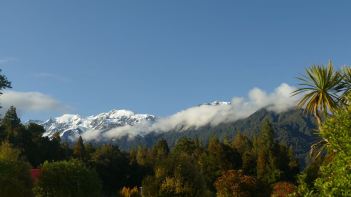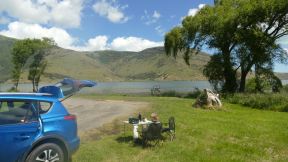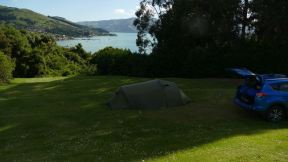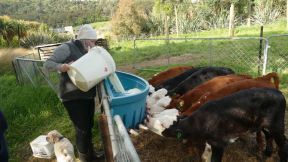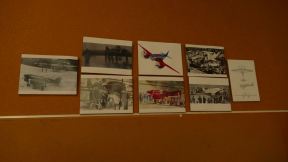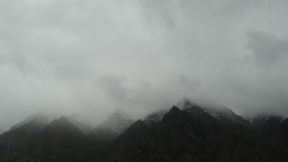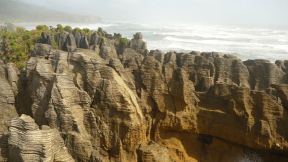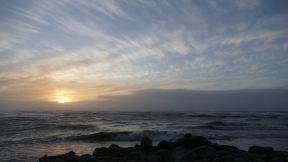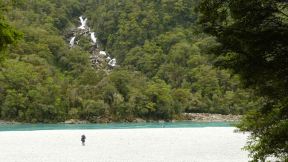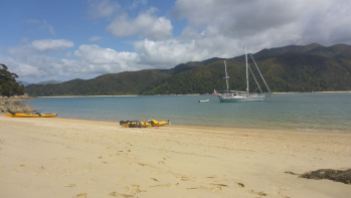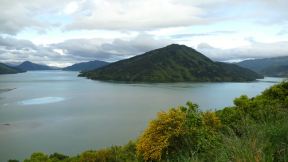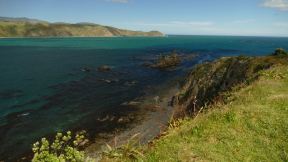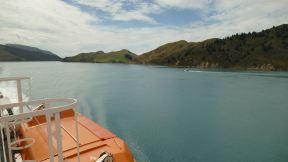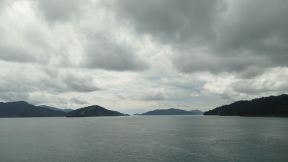Things we learned: Always double-check the room
“And don’t forget your toothpaste. You guys always leave me dozens of toothpastes. You always forget stuff here and I end up with buckets full of toothpastes.”
Agra is the host of our hostel in Oamaru (“Swaggers Backpackers”). She is a real special woman. She is well in her seventies and maybe a little bit crazy, but in a cool and friendly way. “My name is Agra, like Viagra, and my dog is called Laika, because ‘the kids like‘er‘”she said.
She is super helpful and sweet, gave us good tips about the penguins and likes to talk to her guests. And at the same time she is constantly complaining about them. It was quite amusing. She was talking to us as if we were representatives of all her past guests. Telling us about all the things “you guys always do”. She has two sons that when coming home stay outside in a campervan because “they rather shoot them selves in the head than staying with you guys”.
We really liked her with her sweet character and rough language. “I am never out of town for a long time. When I go the other hostel-owner ask: ‘where the f… is she?’ and that’s why I never go away.”
She likes to talk, talks a lot and is really entertaining in her own little way.
And of course she didn’t stop when we were about to leave: “Hey listen Andy, have you got everything with you? Don’t forget your phone chargers, I have a bag full of phone chargers. Aww, you guys always forget stuff here.”
We left the hostel with a grin and walked around the town a little bit. The night before we ran around it to see blue penguins that walk around the streets everywhere. Now the streets are busy, tourists take pictures and walk the streets from café to café.
We leave the town and with a big loop inland we arrive in Timaru. That’s when Christy realized she forgot her boots at the Swaggers Backpackers.
A call with Agra confirmed this. : “Oh well, Andy. Yes you forgot your shoes here? How much were they? Where are you now?”
We were in fact not far away. On the most direct way it was only one hour. And so we drove back through the pouring rain, the night and flooded streets to get back the boots.
And so we could tell Agra farewell a second time. “Thank you so much for the fun time and the penguin tip, Agra”
And we learned something that we knew so well already: it is always worth a last scan through the room before you leave.
Stuff we saw:

Roaring sea at the Otago peninsula
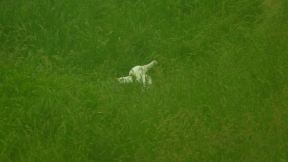
An Albatros. The largest seabird. Quite impressive, even though we didn’t see them fly.

Some seagulls with their little ones.

It poured rain….

Christy concentrated on the puddles and the traffic.

The Moeraki Boulders

Nice shapes

The sea was wild these days.

waves hitting the coast hard.

The empty streets of Oamaru at night. It is a nice place…

When you know where to go you find these little fellas. Blue penguins.

They come back from their fishing trip and go home to their girlfriends.

The town has a lot of old stone buildings. Really nice.

The town is nice during the day too… an old Whiskey distillery.

It is a pleasant place to stroll through the streets.

The Steampunk Headquarter. A very unique place

the place is full of weird constructions of all kind.

Very cool displays…

A fantasy train It featured a movable machine gun…
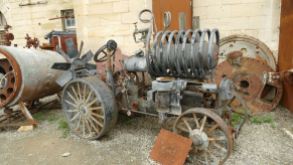
Cool fantasy tractor…

Amazing what people come up with….

This is the world of steampunk: a fantasy world where highjack machines are driven by steam and the theme is the victorian age…

This was a really cool room behind that door….

The place had 3x3m and mirror ceiling, floor and walls. Some bulbs hanging from the ceiling and you have the most amazing room….

huge flies on the wall

Not everything looked welcoming here…
Stuff we did:
We pitched our tent in Portobello just outside Dunedin. Our plan was to see the Albatros colony on the edge of the Otago peninsula.
The birds were breeding and with the pouring rain they did not feel like flying a lot (who would blame them).
We continued up north and when I say it poured rain I mean pouring. The roads were flooded, all the fields turned into large lakes, all the green hills featured massive rivers on the grass. Passing trucks and cars splashed buckets of water on our windshield. And we had to slow down to walking pace to cross the flooded parts of the roads.
We made it to Oamaru and had a stop at the beach to see some perfectly round Moreaki boulders being washed in the sea. It was raining pretty hard, so we had the beach to ourselves.
With the pouring rain the decision to stay in a hostel was an easy one.
The lady who ran the hostel was super nice and showed us where we would find penguins running around at night in the town.
And indeed, when we walked to deserted roads of Oamaru suddenly they appeared: cute little blue penguins running all over the street. They have their nests in little holes in the old buildings. The locals know that, but most tourists are sent to a colony they set up in the town. Artificial little huts and an arena like area where the tourists sit and watch the penguins to walk home from their fishing trip. Nothing wrong with that, but of course it is nicer to see them in the “wild”.
We had a look at the Steampunk Headquarter and enjoyed the old town with a lot of steampunk scenery. Steampunk is a real thing in this town, so it was fun to look at all the stuff some real creative people come up with.

















